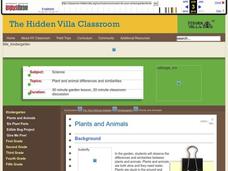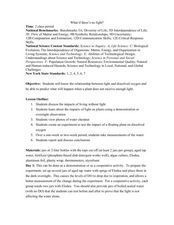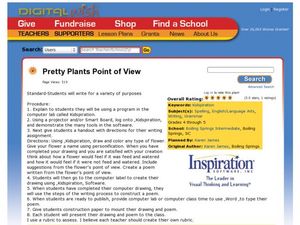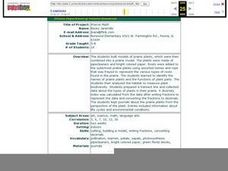Curated OER
What's Growing? Lesson Plan
Young scholars study the life cycle of plants by growing a seed in a paper cup. They record observations of the changes they see. When the plant sprouts, they plant it in soil in a paper cup. Next, they continue to draw and date their...
Curated OER
Pop-Up Wildlife Mural
Students research life in a rainforest including plants, animals, insects, climate. They discover reasons for the importance of rainforests to the Earth's environment. Students work as a group to create a large 3-D rainforest scene that...
Curated OER
Ocean Scenes and Coral Reefs
Young scholars explore plants and animals that live at various ocean levels, including beaches and coral reefs. They demonstrate their comprehension of ocean layers and life with chalk drawings. Students draw details of plant and animal...
Curated OER
Plants and Animals
Students taste test the garden. In this Science lesson, students compare and contrast plants and animals needs. Students pick fruits and vegetables in the garden and discuss their observations.
Curated OER
Will It Grow?
Fifth graders conduct experiments involving plants. In this science lesson, 5th graders design an experiment involving plants. Students use the scientific method to design their experiments.
Curated OER
Cellular Models
Each student construct a model of a cell on a large cookie, including the parts which were discussed during lecture.? Half of the class will be instructed to make plant cell models and the other half will be in charge of animal cell...
Curated OER
What If There's No Light?
students discuss the importance of light and the consequences of living without it. Using a plant as a demonstration, students predict and observe what happens to a plant when it does not receive enough light. In groups, they experiment...
Curated OER
Where Did Foods Originate? (Foods of the New World and Old World)
What do papayas, peanuts, pineapples, and potatoes have in common? Why, they are foods explorers brought back to the Old World. Young researchers use the Internet to investigate how New World explorers helped change the Old World's diet....
Curated OER
Unit 21 Terrariums
The history of terrariums and how to construct one are presented in this PowerPoint. Each important step aspect of terrarium care is discussed: selecting a container, drainage, soil, types of plants, and maintenance. You will want to...
Curated OER
Basic Needs of Living Things - Lesson Two
Fourth graders study and identify the basic needs of a variety of organisms. Terrariums and aquariums are used to demonstrate what plants, animals, and fish need to stay alive. These two classic models are used to effectively convey what...
Curated OER
Physical Changes Pre-Quiz
Quiz the class on what they know before you teach it. This assessment will give you an idea of what basic scientific concepts are known to your learners. Physical change, state of matter, and basic plant and animal needs are covered.
Curated OER
The Alphabet Garden
Third graders transplant, tend and observe a plant for each letter of the alphabet in a school garden. They work individually to research and select a plant that will grow in their local climate. Students then care for and observe the...
Curated OER
Pretty Plants Point of View
Young poets use Kidspiration to draw a flower, personify the flower, and write a poem from the flower's point of view. Sharing these poems in small groups will reinforce learners' knowledge of personification.
Curated OER
The Layers of the Rainforest
Fourth graders identify the different layers of the rainforest and distinguish between the plant and life forms that go along with each layer. They access websites imbedded in this plan and answer questions and draw pictures of plants...
Curated OER
From Seeds to Salad Bars
Students examine different plants and discover how they can be sources of healthy food choices. They identify tips on how they can eat more fruits and vegetables during the day. They also prepare a recipe.
Curated OER
Chocolate Fever
Students study plants in the rainforest. They complete a variety of activities surrounding the subject of chocolate. They create new candy bars, invent learning games and write poetry--all focusing on chocolate.
Curated OER
Plant Growth and Carbon Dioxide
Young scientists show how carbon dioxide in the air affects plant growth. This math and science lesson provides a good platform for learners to combine scientific knowledge with mathematical representation of data. A simple, yet...
Curated OER
Science Crossword Puzzles: Life Science
Review some simple life science terms using this short and simple crossword puzzle. Young scientists find 6 terms about photosynthesis and other life science topics using provided clues and then plug them into a crossword.
Curated OER
Fly a Leaf
Young scholars explore which leaves catch the most wind. For this science lesson, students race or fly leaves along a leaf line in order to find out the effects of wind on leaves and plants.
Curated OER
Prairie Math
Students work together to build models of prairie plants. Using the model, they estimate the height and then measure them using metric and standard units. They write a fraction to represent their part of the whole set and compare and...
Curated OER
Ready for Roots
Fourth graders sort seeds and predict what conditions are needed for them to germinate. They keep the seeds moist, observe and measure their growth and graph the results. As the seeds start to grow students compare and contrast the each...
Curated OER
Why Is There Rain In The Forest?
High schoolers explore the tropical rain forests. They investigate the locations of rain forests and the plants and wildlife that is found in them. Students discover the resources found within the forests.
Curated OER
Mounting Dried Plant Samples
Young scholars take samples, mount, and identify plant samples of the school community.
Curated OER
Plant Diversity and Distribution
Students construct a defined plot on school grounds and observed patterns in plant life. They count trees, shrubs, cacti and record on a data sheet. They compare data and generate a plant diversity overlook for their school.

























